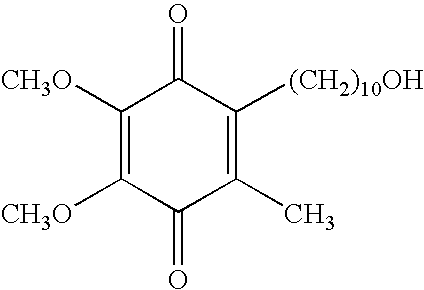Method and preparation for reducing sunburn cell formation in skin
a technology of sunburn cells and skin, applied in the field of skin reducing sunburn cell formation, can solve the problems of significant number of sunburn cells, and achieve the effects of reducing the formation of sunburn cells in human skin
- Summary
- Abstract
- Description
- Claims
- Application Information
AI Technical Summary
Benefits of technology
Problems solved by technology
Method used
Image
Examples
example 1
[0058] Idebenone-containing Formulas 1, 2 and 3 were prepared as follows:
w / w %Formula:123Idebenone1.00.100.01SD Alcohol 40B75.075.0075.00DI Water24.024.9024.09
[0059] To prepare Formulas 1, 2 and 3, the idebenone was added directly to the SD Alcohol 40B while stirring until dissolved. DI Water was then added to the solution with continued stirring.
example 2
[0060] The idebenone-containing Formulas 1, 2, and 3 of Example 2 and a non-treated control (NT) were applied to human skin in a 2-week human sunburn cell assay study.
[0061] The panel composition was six different healthy adult volunteers between the ages of 18 and 53. All were in excellent health, and without any significant internal or dermatological diseases. The subjects were carefully screened to ensure they were not taking any medications. All had a clear back free of blemishes or a tan and were of skin types II and III according to the following classification scheme: [0062] Type I: always burns easily, never tans (sensitive) [0063] Type II: always burns easily; tans minimally (sensitive) [0064] Type III: burns moderately; tans gradually—normal skin (light brown)
[0065] The subjects were given detailed instructions to avoid any direct exposure to sunlight and to minimize any incidental exposure to their backs for the entire duration of the study. No other topical products we...
example 3
[0075] An Idebenone-containing Formula 4 and a Formula 5 (Placebo) were prepared as follows:
w / w %Formula:45Idebenone0.5—SD Alcohol 40B67.567.5DI Water22.022.5Ammonium Glycolate10.010.0and Glycolic Acid(Neutralized to 3.8)
[0076] To prepare Formula 4, the idebenone was added directly to the SD Alcohol 40B while stirring until dissolved. DI Water was then added to the solution with continued stirring followed by 10% Ammonium Glycolate and Glycolic Acid (Neutralized to 3.8). To prepare Formula 5, the same procedure was followed except that idebenone was not added to the composition.
PUM
| Property | Measurement | Unit |
|---|---|---|
| wavelength | aaaaa | aaaaa |
| wavelength | aaaaa | aaaaa |
| wavelength | aaaaa | aaaaa |
Abstract
Description
Claims
Application Information
 Login to View More
Login to View More - R&D
- Intellectual Property
- Life Sciences
- Materials
- Tech Scout
- Unparalleled Data Quality
- Higher Quality Content
- 60% Fewer Hallucinations
Browse by: Latest US Patents, China's latest patents, Technical Efficacy Thesaurus, Application Domain, Technology Topic, Popular Technical Reports.
© 2025 PatSnap. All rights reserved.Legal|Privacy policy|Modern Slavery Act Transparency Statement|Sitemap|About US| Contact US: help@patsnap.com


